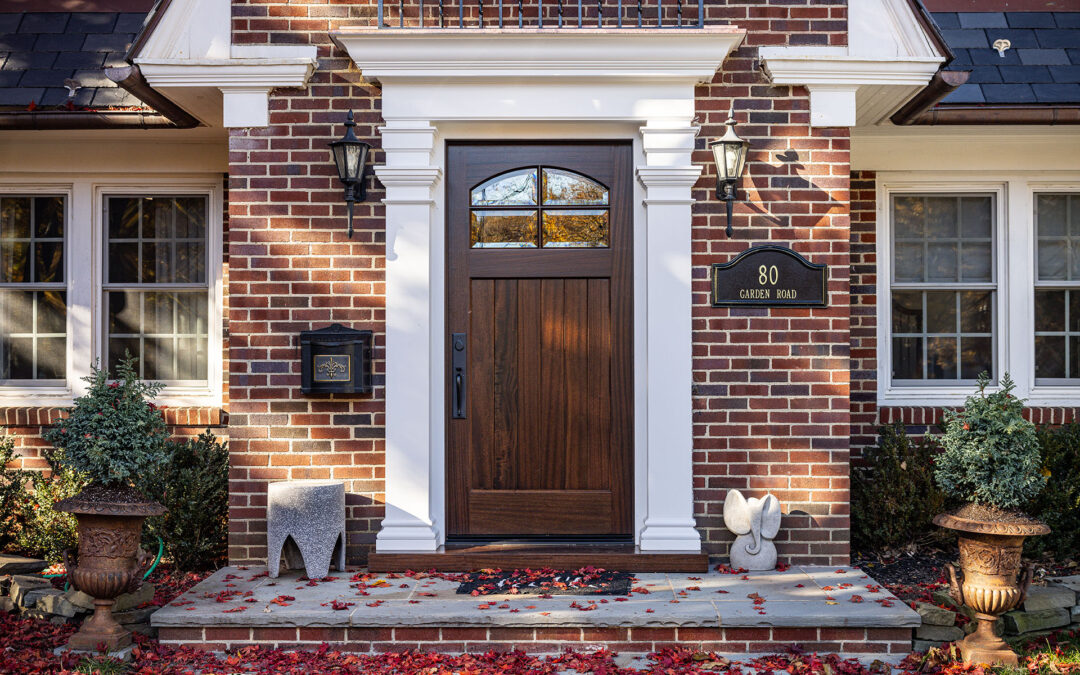
Dec 15, 2025 | Custom Doors
Through centuries of changes and improvements in door manufacturing, one timeless truth remains: Wood stands apart as the material of choice for truly exceptional doors.
Intrinsic Beauty
The natural beauty of wood is unmatched. Metal, fiberglass, and composite doors have their place, but none capture the authenticity and signature appearance of real wood. Different species’ grain patterns, subtle tonal shifts, and organic textures provide pure character. The grain might swirl here or run straight there, subtle variations that lend depth and richness that no synthetic surface can imitate. In luxury design, where authenticity absolutely matters, these nuances make a wood door a statement piece.
Design Flexibility
Beyond its aesthetics, wood offers unmatched flexibility in design. Whether your vision is an oversized double door, a sweeping arch, an elaborately carved statement door, or a sleek, minimalist panel design, wood can be shaped, milled, carved, and finished to your exact specifications. This freedom is a key reason architects and builders continue to choose wood when designing high-end homes, event venues, and other structures. The ability to control detail, proportion, and style, from raised panels to intricate moldings, simply isn’t matched by metal or fiberglass alternatives.
Architectural Presence
A luxury wood door gives a sense of permanence, history, and craftsmanship. It doesn’t just fill an opening — it establishes the tone of a structure. A solid wood door communicates heritage and gravitas in a way that lighter, mass-produced doors can’t. Its weight, texture, and finish create a sense of arrival that resonates physically and emotionally.
Human Craftsmanship
Part of what gives luxury wood doors their enduring appeal is the craftsmanship behind them: selecting the wood for grain and character, orienting staves for structural integrity, crafting durable joinery, hand-sanding surfaces, and applying layered finishes that highlight the wood’s natural beauty. The result is a door that feels intentional and personal — a human expression, not a factory product. This kind of craftsmanship brings material and maker together in a way that adds layers of value beyond mere utility.
Longevity & Repairability
Wood doors also offer long-term durability. They can be repaired, refinished, and repainted over decades. Unlike doors made of fiberglass or steel, which may need replacement after weather exposure or wear, a wood door can be sanded, repaired, and brought back to life. That renewability can make a door a multigenerational investment rather than a one-time purchase.
Superior Sensory Experience
Most of all, wood delivers a broad sensory experience: a warm visual appeal, a satisfying weight in your hand, a solid and reassuring sound when it closes. These subtle cues communicate quality and presence. When you’re looking to create a premium, high-end experience, those details make a real difference.
Wood: A Hallmark of Premium Craftsmanship
For truly luxurious doors that combine beauty, flexibility, craftsmanship, sensory appeal, and enduring value, wood remains unmatched. If you’re considering an upgrade, refurbishing your business’s entrance, or designing a home to leave a lasting impression, talk with us at Vintage Millwork & Restoration and discover the difference a luxury custom wood door makes.
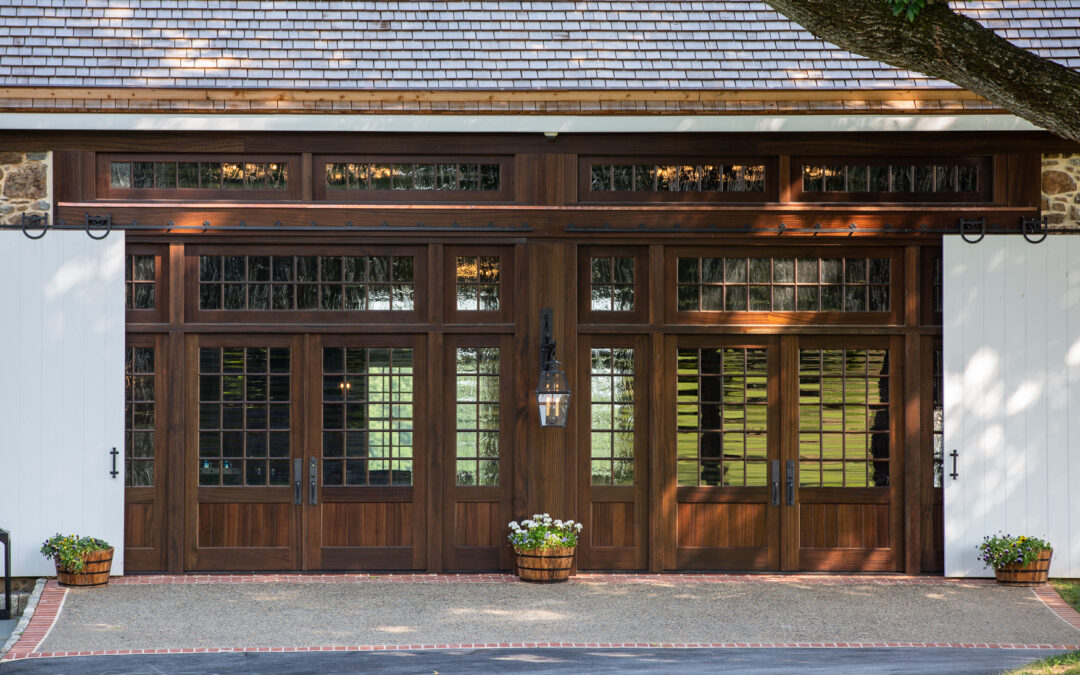
Sep 23, 2025 | Custom Doors
When selecting the optimal wood species for a luxury door, whether interior or exterior, it’s typical to compare hardwoods like mahogany, oak, and walnut. While these woods exhibit qualities that can make them ideal for certain applications, sapele (suh-peel-ey) mahogany, a West African hardwood, is a superior option when considering its combination of beauty, durability, sustainability, and cost.
The Science
A high-end exterior door must resist wear, weather, rot, shrinking/swelling, impact, and insect attack. And while an interior door is sheltered from some of these issues, it still needs to be durable and stable. For both uses, sapele shines.
-
- Density & Hardness: Sapele has a higher density than many mahoganies. It has a specific gravity of around 0.64–0.71, with a Janka hardness of about 1,410 lbf (pounds-force).1 That makes it significantly more resistant to dents and deformation.
- Rot & Decay Resistance: Its heartwood has a natural resistance to decay and insect attack.2 While not entirely immune to moisture, with proper finishing and sealing, sapele mahogany delivers high performance in exterior applications.1
- Dimensional Stability: Sapele’s shrinkage values are moderate (radial ~4.8%, tangential ~7.2%),1 which results in a very manageable shrink-swell behavior when moisture content changes. This stability helps to ensure doors don’t warp, twist, or gap over time.
Other woods, like classic genuine mahogany, are also rot-resistant and beautiful, but many of them are softer and prone to showing dents and dings, more expensive, or under international regulatory restrictions, which increases their cost and reduces availability. While oak is strong and durable, it doesn’t have the same exotic character as sapele. Walnut, another popular wood species, is more sensitive to environmental fluctuations, making it less ideal for large-format use like entry doors.
Visual Appeal
Luxury doors are as much about visual presence as function, and sapele delivers distinctive character.
-
- Color & Aging: Freshly cut sapele heartwood ranges from golden to rich reddish-brown and dark brown, and it darkens with exposure and age, developing a deeper, more elegant tone. By contrast, walnut tends to lighten as it ages.
- Grain & Figure: One of sapele’s most distinctive features is its interlocked grain, which can appear as ribbons, stripes, or pommele — rounded, bubble-shaped graining. Often, these patterns create beautiful, shimmering cat’s-eye effects, called chatoyance.
- Finish & Luster: When sanded properly and topped with high-quality coatings, sapele’s luster shines through while preserving its intricate texture.
Additional Benefits of Sapele
-
- Workability: Despite its hardness, sapele can be carved and machined well by experienced craftsmen with proper tools. It holds nails, screws, and adhesives strongly, making it well-suited for complex door designs like panels and inlays.
- Cost & Availability: Because sapele is more abundant and less regulated compared to some mahogany species, its cost per board foot is often lower for similar visual and performance quality.3
- Sustainability: Responsible sourcing, forest certification, and trade regulation can ensure the sapele wood used in luxury doors comes from well-managed forests.
The Best of All Worlds
For builders and architects, sapele mahogany offers a sweet spot of exceptional durability and hardness, visual richness, workability, and sustainability. For discerning homeowners, the wood’s elegance and performance make a statement that complements any décor or style.
To learn more, or to get started on your own custom sapele door project, contact the experts at Vintage Millwork & Restoration.
Sources
-
- “Sapele Mahogany Lumber,” Forestry.com, accessed on September 19, 2025.
- “Sapele,” The Wood Database, accessed on September 19, 2025.
- “Mahogany vs Sapele: A Comprehensive Comparison,” A to Z Wood Company, accessed on September 22, 2025.
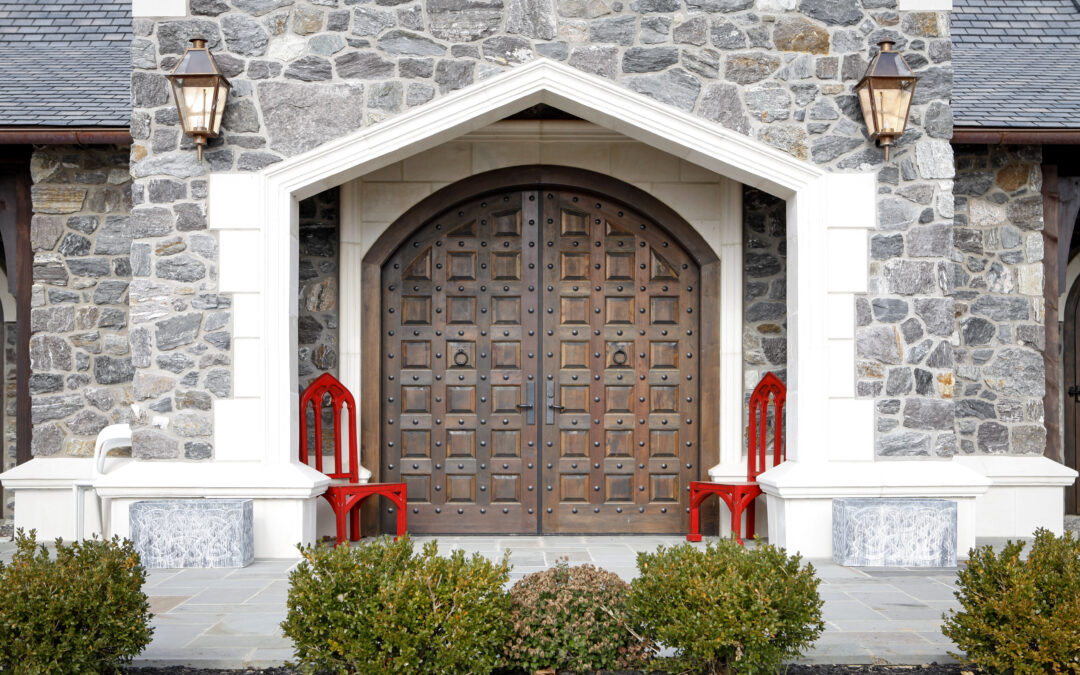
Aug 22, 2025 | Custom Doors
In a high-end home, a luxury custom door does more than serve as an entry or passageway. It defines the architectural language of a property, creates a lasting impression, and sets the tone for the experience that lies behind that door. In elite residential design, the right door becomes a statement of taste and architectural intent. With so many door styles available, we’ve curated a list of standout options that elevate luxury residences, each with unique strengths and ideal aesthetic contexts.
1. Arched Doors: Old-World Grandeur
-
- Why They Work: Arched doors evoke timeless elegance. Their curves soften a home’s façade or interior and convey custom craftsmanship and European charm.
- Design Features: Common features include hand-forged iron accents, wood carvings, and oversized hardware. Arched doors’ shape adds grandeur and depth unmatched by rectangular styles.
- Best For: Mediterranean villas, Tuscan estates, Gothic manors, or French country homes.
2. Dutch Doors: Charming Versatility
-
- Why They Work: Dutch doors, with their defining horizontal split, blend charm and function, allowing the top half to open independently of the bottom.
- Design Features: Glass-paneled tops and customizable finishes make these doors ideal for both utility and style.
- Best For: Transitional homes, upscale farmhouses, or informal yet luxurious mudroom and kitchen entrances.
3. French Doors: Symmetrical Elegance
-
- Why They Work: French doors offer symmetry, transparency, and light, key elements in refined interiors.
- Design Features: Multi-light panels, decorative grilles, and solid wood frames offer elegance while opening up sight lines and space.
- Best For: Patios, living room openings, or owner’s suite balconies.
4. Double Doors: Grand Statements
-
- Why They Work: Expansive and elegant, double doors enhance scale and add a formal, inviting presence.
- Design Features: These doors are often paired with sidelights or transoms and can include carvings, moldings, and other detailed craftsmanship that’s ideal for large-format architecture.
- Best For: Colonial mansions, traditional estates, and homes with generous entry halls.
A Doorway to Further Customization
Doors can be customized to a greater extent with additional artisanal touches such as carvings, high or low relief ornamentation, and layered moldings. Applying a distressed finish adds character and can render an eco-conscious appeal, providing an interesting contrast in rustic-modern or mountain retreat interiors. Likewise, rich stains or painted finishes take any door to a new level of customization.
Elevate with Intent
The perfect door for a high-end home is more than just an architectural detail. It’s a convergence of form and function that tells the story of a home, about its history, its intent, and the family who lives there. Whether it’s the stateliness of a double door, the charm of a Dutch door, or the elegance of arched and French doors, each style serves as an extension of the home’s identity and the lifestyle within it.
Ready to transform your entrance? Contact our design team to explore exquisite options that will elevate your luxury build with a door that speaks volumes.
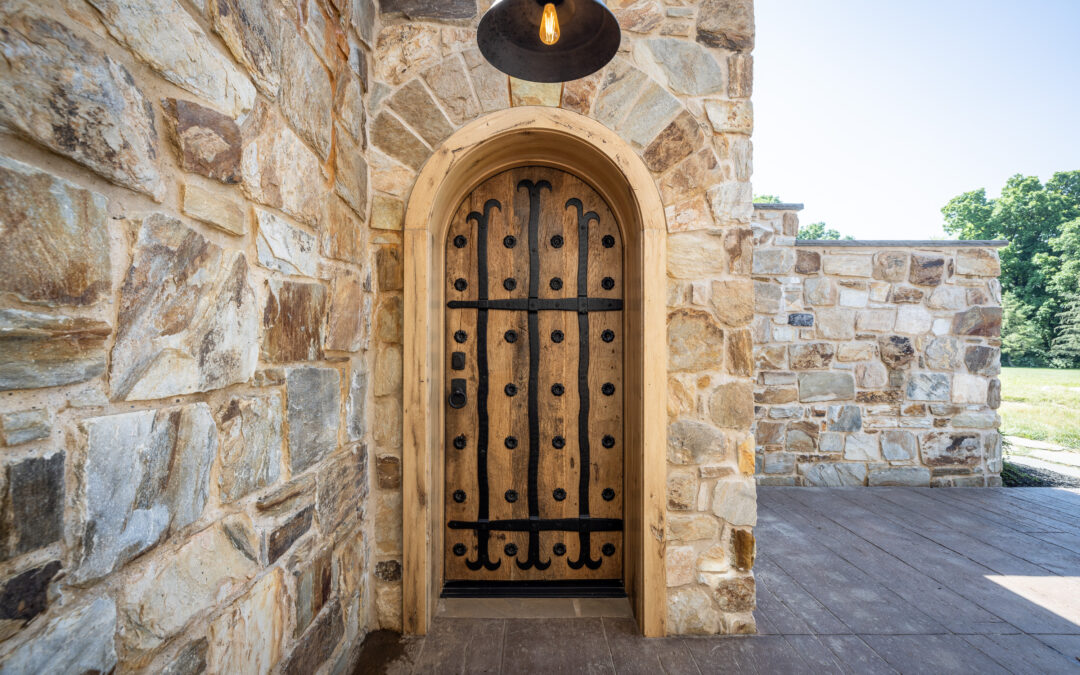
Jun 19, 2025 | General Interest
Across the globe, doors serve as more than mere architectural necessities. They are entryways rich with symbolism, steeped in history, and often designed to reflect the values, beliefs, and artistic traditions of a people. Whether spiritual, social, or practical, doors tell stories about identity, power, protection, and welcome. Let’s explore how doors function symbolically in different parts of the world.
Morocco
Moroccan doors are among the most visually striking in the world. Known for their intricate geometric carvings, horseshoe arches, and vivid hues — especially the iconic blue found in the city of Chefchaouen — a blend of Islamic tradition and colonial influence shapes these doors. The height of Moroccan doors often requires visitors to bow slightly when entering, creating a built-in gesture of humility and respect.
India
Many Indian doors, particularly those of temples and palaces, are carved with scenes from mythology or with images of deities or protective guardians. These ornate doors serve as thresholds to the divine, representing spiritual transition. Often decorated with metal studs, bells, and floral motifs, Indian doors may also feature colorful hangings called torans. They are typically made from fabric, beads, or flowers and celebrate love, devotion, and hospitality.
Europe
Throughout Europe, doors have long signaled personal and cultural values. Red doors symbolize hospitality and protection and are typical of Lutheran and some other Protestant churches. Green denotes peace and prosperity, often seen in Amsterdam as a nod to the city’s wealth and trade. In Italy, fine carvings add artistic grandeur to wooden doors kept in families for generations. French doors often feature elegant ironwork and glass panels, reflecting the country’s preference for elegance. In Ireland and Scotland, residents famously paint their doors in bold colors, a tradition rooted in Celtic culture to symbolize hospitality and attract luck.
West Africa
In many West African cultures, particularly among the Yoruba people of Nigeria, Benin, and Togo, doors are symbolic storytellers. These richly carved surfaces may depict religious ceremonies, royal figures, or spiritual guardians. Found in shrines, palaces, and initiation houses, these doors serve not only to protect but also to record and preserve community heritage. Their artistic depth makes them functional, sacred, and historical all at once.
China & East Asia
In Chinese culture, doors are deeply rooted in feng shui and traditional beliefs. A red door is thought to bring happiness, wealth, and protection. Raised thresholds delineate sacred from secular space. Lion-head knockers add status and security, reinforcing the idea that a door is the first line of both welcome and defense.
The Americas
From colonial to Victorian and mid-century, multiple door styles have remained in vogue throughout North America. Early doors in the American colonies displayed practicality, status, and European heritage. Settlers from the Netherlands famously brought what we now call “Dutch doors.” In the 1800s, doors became ornate and richly carved, followed by solid and more subtly decorated doors in the mid-20th century. But no matter the timeframe, they have usually denoted the prosperity level of the homeowners.
Central and South American doors often reflect diverse native and Iberian cultures in their designs. The paneled symmetry of Spanish Baroque influence can be seen in the oldest cities, while in other places, wooden doors of teak bear vivid coats of blue, pink, or yellow.
More Than Just an Entrance
Incorporating global influences in your doors can speak volumes about your lineage, your travels, or your artistic preferences. While many of the elements described here are most often seen on exterior front doors, they can also be used for interior doors. Whether subtle or bold, these types of design touches make your doors, and your home, uniquely your own.
To explore ideas that will customize your home’s character, contact the experts at Vintage Millwork & Restoration and make your doors mean more.
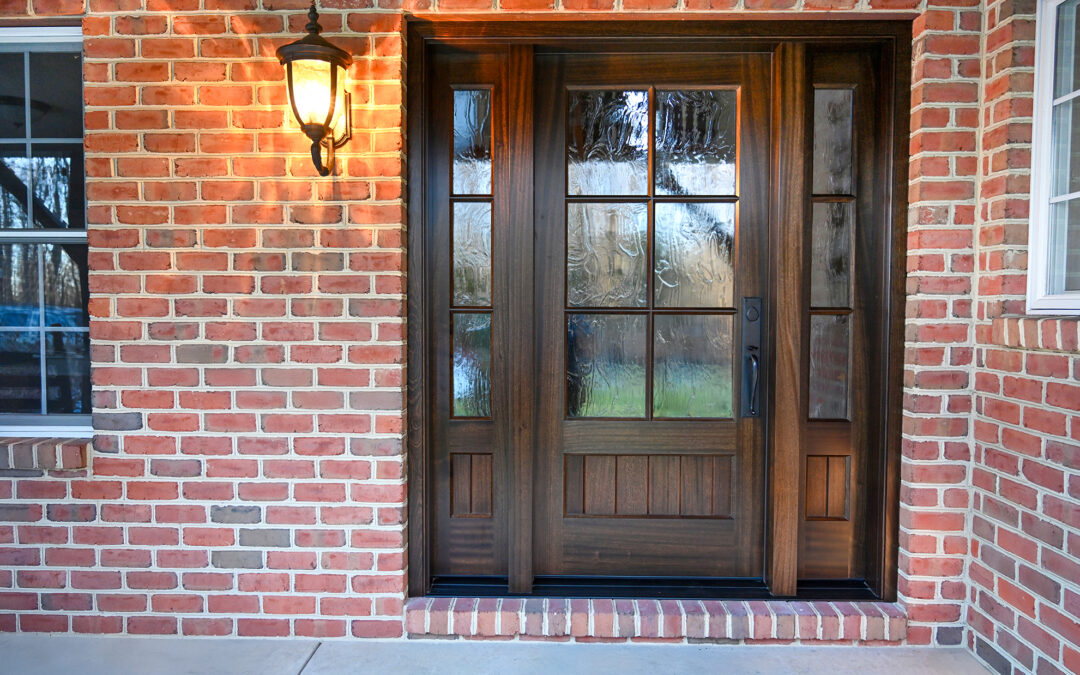
Apr 15, 2025 | Custom Doors
Like an intriguing opening line to a novel, a luxury front door captures the imagination and creates a desire to know more. The punctuation of color and design becomes an essential element and focal point that perfectly finishes off the exterior while arousing curiosity about the rest of the home. But it’s not just the looks of a front door that elevate the home’s aesthetic — it’s also the quality of the build, its materials, and the craftsmanship used in its creation that makes it a desirable addition. Let’s explore seven reasons why adding a luxury front door is an upgrade you shouldn’t overlook.
- It Elevates Curb Appeal – Before anyone even steps inside, a front door makes a statement. A luxury door signals intention and care — it suggests that what lies within is equally curated. For renovations, it has the power to turn a plain façade into a home with presence; for a new build, it announces that this home’s architect and its owners are confident in their creation.
- It Communicates Without Saying a Word – There’s an unspoken language in well-chosen details. Features such as handcrafting, upscale wood selection, custom glass inlays, upmarket hardware, and a refined finish are subtle cues that speak to the quality of a home and the good taste of its designers and owners. Guests and neighbors will notice, as will passersby on the street.
- It Enhances Security in Style – A door upgrade isn’t just about appearances. An engineered door with layers of wood inside a veneer outer layer, with a high-end locking system and a finish that withstands the elements, looks, feels, and performs with strength, protecting the home and giving owners peace of mind.
- Coming Home Feels Like an Occasion – There’s a certain gravitas to opening a beautiful, weighty door at the end of a long day. It creates a sense of arrival, a transition into one’s own curated space, and a way to shut off the outside world.
- It Insulates – Beyond aesthetics, luxury doors are built robustly to insulate. They reduce drafts, lower energy costs, and keep your environment comfortable, all while quietly reflecting a sense of eco-stewardship and attention to detail.
- It Ages with Grace – Where builder-grade doors deteriorate, quality doors last and develop a unique character. The richness of the wood finish gives an established and authentic feel that lesser doors can’t match.
- It’s a Reflection – A front door is a kind of confident introduction. Its materials, build quality, finish or color, and hardware can exemplify confidence and a touch of refinement, artistic courage, or a simplicity of design and quiet dignity. In the end, a luxury wooden door is a statement.
Upgrade to Custom Wood Doors
A thoughtfully chosen front door is more than an entryway — it’s an expression of the homeowner’s personality and a reflection of the designer’s vision. It also enhances the home, both inside and out, with style and functionality. From first impressions of guests to its everyday use by those who live in the home, investing in a high-quality door is an impactful choice. For more information on creating the perfect custom door for your project, contact the experts at Vintage Millwork & Restoration.




